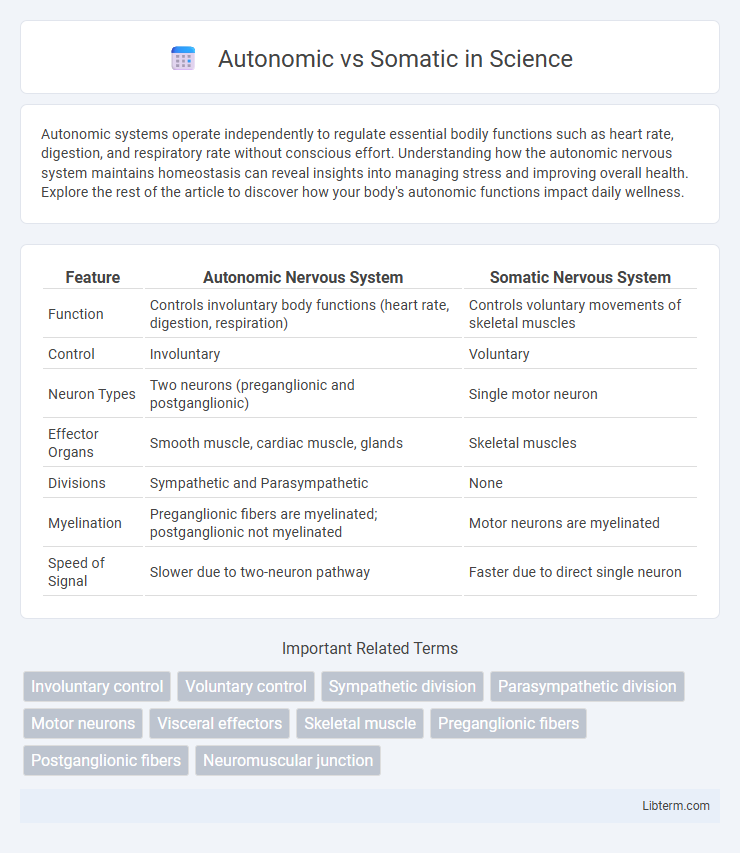Autonomic systems operate independently to regulate essential bodily functions such as heart rate, digestion, and respiratory rate without conscious effort. Understanding how the autonomic nervous system maintains homeostasis can reveal insights into managing stress and improving overall health. Explore the rest of the article to discover how your body's autonomic functions impact daily wellness.
Table of Comparison
| Feature | Autonomic Nervous System | Somatic Nervous System |
|---|---|---|
| Function | Controls involuntary body functions (heart rate, digestion, respiration) | Controls voluntary movements of skeletal muscles |
| Control | Involuntary | Voluntary |
| Neuron Types | Two neurons (preganglionic and postganglionic) | Single motor neuron |
| Effector Organs | Smooth muscle, cardiac muscle, glands | Skeletal muscles |
| Divisions | Sympathetic and Parasympathetic | None |
| Myelination | Preganglionic fibers are myelinated; postganglionic not myelinated | Motor neurons are myelinated |
| Speed of Signal | Slower due to two-neuron pathway | Faster due to direct single neuron |
Introduction to the Nervous System
The nervous system is divided into two main components: the autonomic and somatic nervous systems, each responsible for distinct functions. The autonomic nervous system controls involuntary actions like heart rate, digestion, and respiration, whereas the somatic nervous system regulates voluntary movements by transmitting signals from the brain to skeletal muscles. Understanding these two systems highlights their crucial roles in maintaining homeostasis and enabling conscious motor control.
Overview of Autonomic and Somatic Divisions
The autonomic nervous system controls involuntary bodily functions, such as heart rate, digestion, and respiratory rate, by regulating smooth muscle, cardiac muscle, and glands. The somatic nervous system governs voluntary movements by transmitting motor commands to skeletal muscles and relaying sensory information from external stimuli. Both systems collaborate to maintain homeostasis and enable interaction with the environment through distinct neural pathways and mechanisms.
Structure and Function of the Somatic Nervous System
The somatic nervous system comprises sensory and motor neurons that control voluntary movements by transmitting signals between the central nervous system and skeletal muscles. Structurally, it involves peripheral nerves that innervate muscles and sensory receptors in the skin, facilitating conscious control and proprioception. Functionally, the somatic system enables coordinated muscle contractions for activities such as walking and grasping, playing a critical role in reflex arcs and voluntary motor responses.
Anatomy and Mechanisms of the Autonomic Nervous System
The autonomic nervous system (ANS) regulates involuntary physiological functions through its two main divisions: the sympathetic and parasympathetic systems, which innervate smooth muscle, cardiac muscle, and glands. Anatomically, the ANS consists of preganglionic neurons originating in the spinal cord or brainstem and postganglionic neurons located in peripheral ganglia, facilitating neurotransmission via acetylcholine and norepinephrine. Mechanistically, the ANS operates through reflex arcs and central autonomic networks to maintain homeostasis, modulating heart rate, digestion, respiratory rate, and glandular secretion without conscious control.
Key Differences Between Autonomic and Somatic Systems
The autonomic nervous system controls involuntary bodily functions such as heart rate, digestion, and respiratory rate, operating largely without conscious effort, whereas the somatic nervous system manages voluntary movements via skeletal muscles under conscious control. Autonomic pathways typically involve a two-neuron chain with ganglia, while somatic pathways use a single motor neuron extending from the central nervous system directly to the muscle. Furthermore, the autonomic system is divided into sympathetic and parasympathetic branches that have opposing effects on organs, unlike the somatic system, which solely activates muscles for movement.
Voluntary vs. Involuntary Control
The autonomic nervous system regulates involuntary physiological functions such as heart rate, digestion, and respiratory rate without conscious effort. In contrast, the somatic nervous system controls voluntary movements by transmitting signals from the brain to skeletal muscles. This distinction emphasizes the autonomic system's role in automatic bodily processes, while the somatic system enables intentional motor control.
Neurotransmitters and Signal Transmission
The autonomic nervous system primarily uses neurotransmitters such as acetylcholine and norepinephrine to regulate involuntary functions through slower, multi-synaptic pathways. In contrast, the somatic nervous system relies on acetylcholine for rapid signal transmission to skeletal muscles via direct, single-neuron synapses. These differences in neurotransmitter types and transmission speed highlight the distinct control mechanisms between involuntary autonomic responses and voluntary somatic movements.
Organs and Processes Regulated by Each System
The autonomic nervous system regulates involuntary functions such as heart rate, digestion, respiratory rate, and glandular secretions through its sympathetic and parasympathetic divisions. In contrast, the somatic nervous system controls voluntary movements by innervating skeletal muscles. While the autonomic system modulates smooth muscle, cardiac muscle, and glands, the somatic system exclusively targets skeletal muscles for conscious motor control.
Clinical Relevance and Disorders
The autonomic nervous system controls involuntary functions such as heart rate, digestion, and respiratory rate, with disorders including dysautonomia, orthostatic hypotension, and autonomic neuropathy commonly seen in diabetes. The somatic nervous system governs voluntary movements and sensory information, with clinical relevance in conditions like amyotrophic lateral sclerosis (ALS), peripheral neuropathy, and myasthenia gravis. Understanding the distinct roles of these systems is crucial for diagnosing and managing disorders that affect muscle control, sensation, and autonomic regulation.
Summary and Comparative Table
The autonomic nervous system (ANS) controls involuntary body functions such as heart rate, digestion, and respiratory rate, while the somatic nervous system (SNS) regulates voluntary movements through skeletal muscles. ANS operates through sympathetic and parasympathetic branches to maintain homeostasis, whereas SNS transmits sensory and motor signals to and from the central nervous system. A comparative table highlights that ANS affects smooth muscle, cardiac muscle, and glands with involuntary control, whereas the SNS influences skeletal muscles under conscious control, differing in neuron pathways, neurotransmitters, and functions.
Autonomic Infographic

 libterm.com
libterm.com